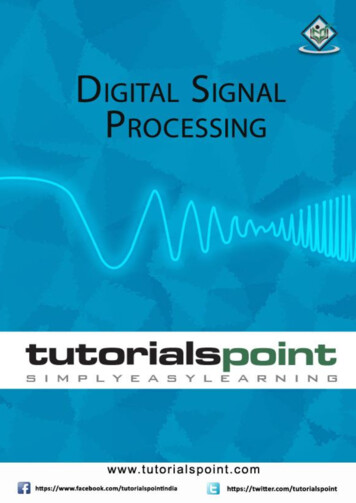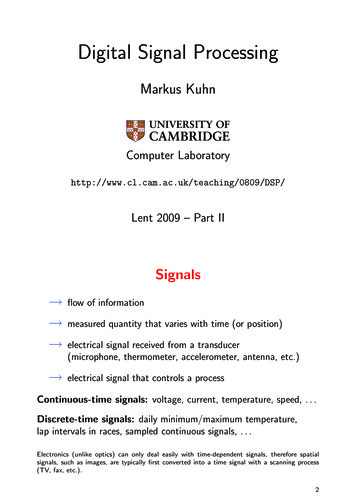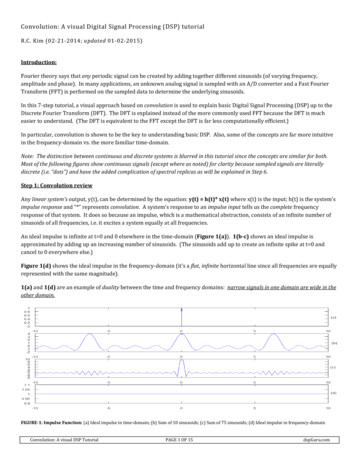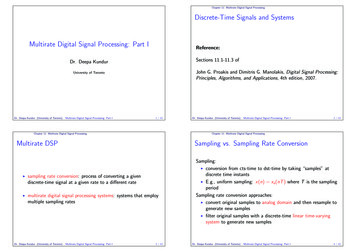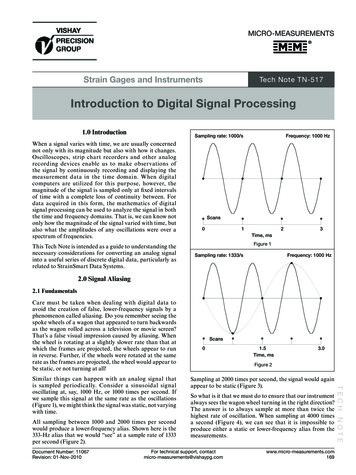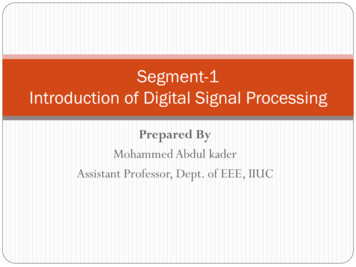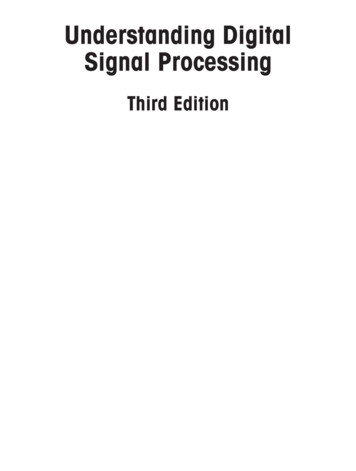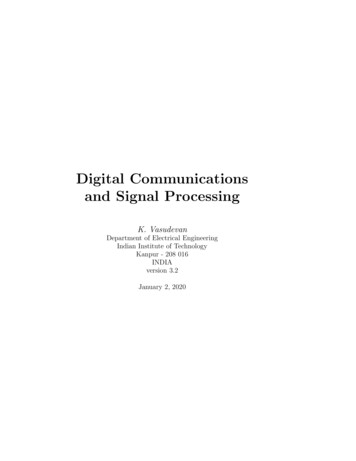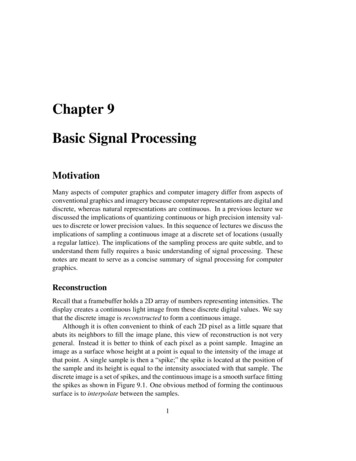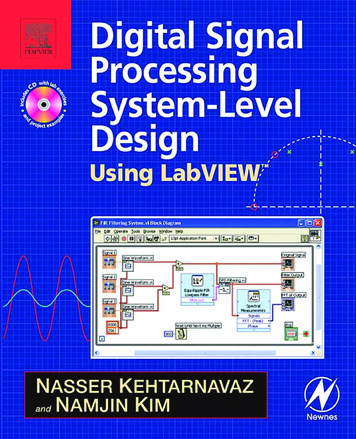
Transcription
Digital Signal ProcessingSystem-Level DesignUsing LabVIEW
Digital Signal ProcessingSystem-Level DesignUsing LabVIEWby Nasser Kehtarnavaz and Namjin KimUniversity of Texas at DallasAMSTERDAM BOSTON HEIDELBERG LONDONNEW YORK OXFORD PARIS SAN DIEGOSAN FRANCISCO SINGAPORE SYDNEY TOKYONewnes is an imprint of Elsevier
Newnes is an imprint of Elsevier30 Corporate Drive, Suite 400, Burlington, MA 01803, USALinacre House, Jordan Hill, Oxford OX2 8DP, UKCopyright 2005, Elsevier Inc. All rights reserved.No part of this publication may be reproduced, stored in a retrieval system, or transmitted inany form or by any means, electronic, mechanical, photocopying, recording, or otherwise,without the prior written permission of the publisher.Permissions may be sought directly from Elsevier’s Science & Technology Rights Departmentin Oxford, UK: phone: ( 44) 1865 843830, fax: ( 44) 1865 853333,e-mail: permissions@elsevier.com.uk. You may also complete your request on-linevia the Elsevier homepage (http://elsevier.com), by selecting “Customer Support”and then “Obtaining Permissions.”Recognizing the importance of preserving what has been written, Elsevier prints itsbooks on acid-free paper whenever possible.Library of Congress Cataloging-in-Publication Data(Application submitted)British Library Cataloguing-in-Publication DataA catalogue record for this book is available from the British Library.ISBN: 0-7506-7914-XFor information on all Newnes publicationsvisit our Web site at www.books.elsevier.com05 06 07 08 09 1010 9 8 7 6 5 4 3 2 1Printed in the United States of America
ContentsPreface.ixWhat’s on the CD-ROM? .xiChapter 1: Introduction . 11.1 Digital Signal Processing Hands-On Lab Courses . 21.2 Organization . 31.3 Software Installation . 31.4 Updates . 41.5 Bibliography . 4Chapter 2: LabVIEW Programming Environment . 52.1 Virtual Instruments (VIs) . 52.2 Graphical Environment . 72.3 Building a Front Panel . 82.4 Building a Block Diagram . 102.5 Grouping Data: Array and Cluster. 122.6 Debugging and Profiling VIs . 132.7 Bibliography . 14Lab 1: Getting Familiar with LabVIEW: Part I . 15L1.1 Building a Simple VI . 15L1.2 Using Structures and SubVIs . 23L1.3 Create an Array with Indexing . 27L1.4 Debugging VIs: Probe Tool . 28L1.5 Bibliography . 30Lab 2: Getting Familiar with LabVIEW: Part II . 31L2.1 Building a System VI with Express VIs. 31L2.2 Building a System with Regular VIs . 37L2.3 Profile VI . 41L2.4 Bibliography . 42v
ContentsChapter 3: Analog-to-Digital Signal Conversion . 433.1 Sampling . 433.2 Quantization . 493.3 Signal Reconstruction . 51Lab 3: Sampling, Quantization and Reconstruction . 55L3.1 Aliasing . 55L3.2 Fast Fourier Transform . 59L3.3 Quantization . 64L3.4 Signal Reconstruction . 68L3.5 Bibliography . 72Chapter 4: Digital Filtering . 734.1 Digital Filtering . 734.2 LabVIEW Digital Filter Design Toolkit . 774.3 Bibliography . 78Lab 4: FIR/IIR Filtering System Design . 79L4.1 FIR Filtering System . 79L4.2 IIR Filtering System . 85L4.3 Building a Filtering System Using Filter Coefficients . 90L4.4 Filter Design Without Using DFD Toolkit . 91L4.5 Bibliography . 94Chapter 5: Fixed-Point versus Floating-Point . 955.1 Q-format Number Representation . 955.2 Finite Word Length Effects . 995.3 Floating-Point Number Representation . 1005.4 Overflow and Scaling . 1025.5 Data Types in LabVIEW . 1025.6 Bibliography . 104Lab 5: Data Type and Scaling . 105L5.1 Handling Data types in LabVIEW . 105L5.2 Overflow Handling. 107L5.3 Scaling Approach. 111L5.4 Digital Filtering in Fixed-Point Format . 113L5.5 Bibliography . 122Chapter 6: Adaptive Filtering . 1236.1 System Identification . 1236.2 Noise Cancellation. 1246.3 Bibliography . 126Lab 6: Adaptive Filtering Systems. 127L6.1 System Identification . 127L6.2 Noise Cancellation . 134vi
ContentsL6.3 Bibliography . 138Chapter 7: Frequency Domain Processing. 1397.1 Discrete Fourier Transform (DFT) and Fast Fourier Transform (FFT) . 1397.2 Short-Time Fourier Transform (STFT). 1407.3 Discrete Wavelet Transform (DWT) . 1427.4 Signal Processing Toolset . 1447.5 Bibliography . 145Lab 7: FFT, STFT and DWT . 147L7.1 FFT versus STFT . 147L7.2 DWT . 152L7.3 Bibliography . 156Chapter 8: DSP Implementation Platform: TMS320C6x Architectureand Software Tools . 1578.1 TMS320C6X DSP. 1578.2 C6x DSK Target Boards . 1618.3 DSP Programming . 1638.4 Bibliography . 166Lab 8: Getting Familiar with Code Composer Studio. 167L8.1 Code Composer Studio . 167L8.2 Creating Projects . 167L8.3 Debugging Tools . 173L8.4 Bibliography . 182Chapter 9: LabVIEW DSP Integration . 1839.1 Communication with LabVIEW: Real-Time Data Exchange (RTDX). 1839.2 LabVIEW DSP Test Integration Toolkit for TI DSP . 1839.3 Combined Implementation: Gain Example . 1849.4 Bibliography . 190Lab 9: DSP Integration Examples . 191L9.1 CCS Automation . 191L9.2 Digital Filtering . 193L9.3 Fixed-Point Implementation . 202L9.4 Adaptive Filtering Systems . 206L9.5 Frequency Processing: FFT. 211L9.6 Bibliography . 220Chapter 10: DSP System Design: Dual-Tone Multi-Frequency (DTMF)Signaling . 22110.1 Bibliography . 224Lab 10: Dual-Tone Multi-Frequency . 225L10.1 DTMF Tone Generator System . 225vii
ContentsL10.2 DTMF Decoder System . 228L10.3 Bibliography .
v 0reface ix 7hatsonthe# 2/- x i
